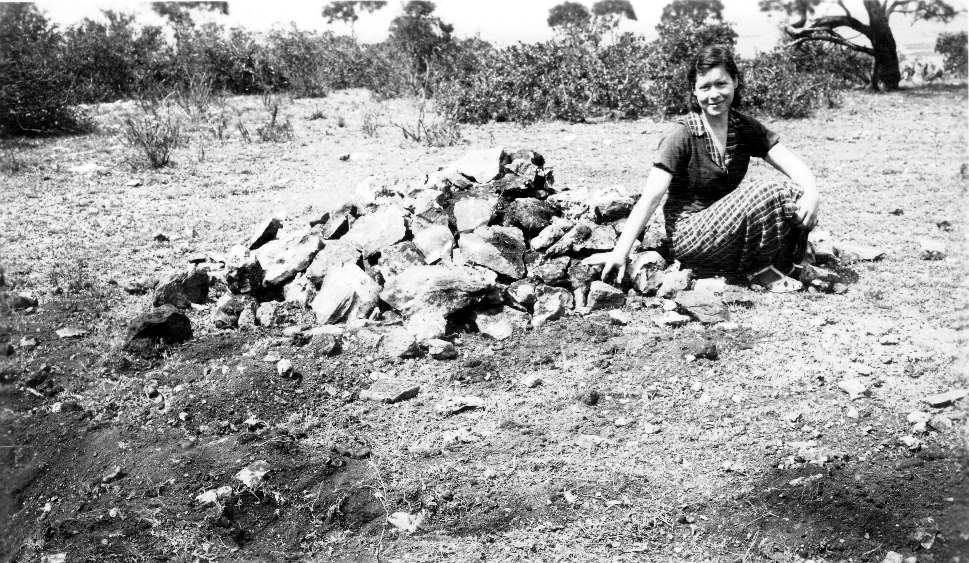Two sites, 41MK26 and 41MK2, in McCulloch County are notable as the southernmost recorded cairn burial sites identified for this study. Located roughly 20 miles northwest of Brady, both sites are on private land.
Site 41MK26 lies on top of a bluff of the Brady Mountains overlooking the Colorado River valley. Reported by landowners to the University of Texas at Austin, it was excavated in 1936 by A.M. Woolsey.
Two burials—one an adult, the other a child (AY2 and AY3)—were recorded. On the surface, the cairn appeared as a large pile of rocks roughly 10 inches high and 10 feet in diameter. Skeletal remains of the adult were detected at about 5 inches below surface. Based on the disarray of the bones, Woolsey determined AY2 was a secondary bundle burial, partially cremated, that had been disturbed by ground movement and animals.
The skeleton’s head was to the southwest. It appeared to have been put with the top down. The skull was cracked and the frontal bones were not more than 2 inches from the bones of the back of the head, therefore it is concluded that there had been some movement of the bones in the settling of the earth.
There was no regular or usual arrangement of the bones, but the arrangement and jumbled up condition would cause one to think that the deceased had met death away from his friends and had been dismembered, and that the bones were later gathered up and put in the grave in a bundle.
The lower jawbone and teeth were found on the east side of the head, but the upper jaw was not found. A femur was lying against the side of the head. The skull had been in the fire. All around the eye sockets the bones were badly burned. …There were no ashes or charcoal in the grave and none of the other bones showed signs of fire, hence it is concluded that the burning had not been done in the grave. Judging from the size of the bones, the skeleton was that of a woman or youth.
Less than two feet from the adult burial, the partial remains of a small child had been placed in a round hole 9 inches in diameter and 6 inches deep. Remnants of a skull had been placed atop the other bones, which were in extremely deteriorated condition. The body may have been placed in a sitting position with the head up, but Woolsey noted he could not verify this.
41MK2
Another cairn burial site (AY1) was documented on a neighboring ranch several miles distant. (Originally reported with the burials above, the site now is recorded separately as 41MK2.) The cairn was situated on a promontory jutting out from a bluff above the Colorado River valley.
Prior to alerting the University crew, landowners had removed three skulls or parts of skulls from underneath a large pile of rocks measuring some 8 feet across and about 1 foot high. It was recalled that the skeletons had been arranged in a sitting position with heads facing downward. Most of the human remains, one of which was described as child-sized, were removed from the grave, along with a small number of mussel shells.
Woolsey’s investigation at Site 41MK2 detected the apparent original grave pit, still containing the remains of an adult:
An almost round hole, 54 inches in diameter, had been dug up by the Indians. At a depth of 13 inches, a soft limestone rock about 6 inches in thickness was found, forming a stratum. The Indians had dug through this. From this the edges of the outlines of the grave could be determined. In the northeast corner, or side of the hole, a round hole 6 inches in depth and 19 inches in diameter was dug and in this were found the body bones of an adult.
These bones were in a peculiar position, the pelvis being in the middle of the 19 inch hole, and on its back side. Three vertebrae were extending to the west. The ribs were in such a position as to cause one to think that the body had been placed in the grave with the buttock on the bottom of the grave and, and the body had then been bent over so that the breast was over the pelvis and the shoulders were up.
Although the skull from this individual was gone, Woolsey thought it likely had been taken out by the landowner. Next to the remains of the adult, the vertebrae and three ribs of a smaller individual were found. Given the prior removal of some of the remains, it is unclear how many individuals were originally in the grave at 41MK2.
|
The arrangement and jumbled up condition [of the bones] would cause one to think that the deceased had met death away from his friends and had been dismembered, and that the bones were later gathered up and put in the grave in a bundle.
-A. M. Woolsey, on Burial AY2, 1936 |

Bundle burial of adult (AY2). Laid atop solid rock, the remains occupied a space only about 18 inches long, 12 inches wide, and 12 inches in depth. Adapted from photo by A. M. Woolsey. TARL Archives.  |

Pile of rocks taken off grave AY2 at 41MK26. Note variation in rock sizes. Photo by A.M. Woolsey. TARL Archives.  |

The burial of the adult at 41MK2 (AY1) appeared as if the body had been placed in a sitting position with torso bent over the knees. Drawing by A. M. Woolsey. TARL Archives.  |
|